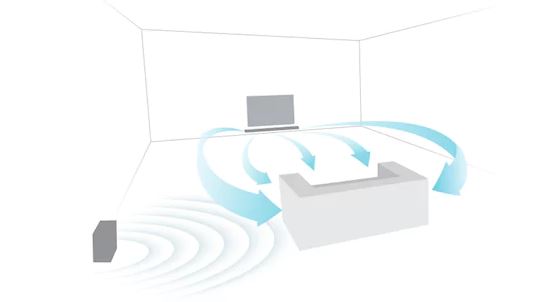If you’ve ever visited a decent movie theatre, then you’ve probably experienced true surround sound. It’s the kind of immersion that gets people to go to the movies in the first place, and it provides something that you can’t get at home without some hefty investments. Humans ears are fine tuned to hear the directionality of sound, and a good surround sound setup will throw sound at you from all sides to fully take advantage of our aural perceptions.
Sadly, recreating real surround sound in your own home isn’t easy. It’s expensive to purchase the six-to-eight speaker setup you need, and equally difficult to find the space to correctly position all of that equipment. Even for a spacious room, you might not want to end up with a clutter of cables. Not everyone wants giant speaker equipment dominating their home to begin with, which is why devices like sound bars are so common.
But there’s a vast distance between real surround sound and zero surround sound. Just because you don’t have a full surround sound setup doesn’t mean you can’t experience surround sound at all. Even if you’re using a front-facing 2.0 channel system, virtual surround sound can be a highly effective alternative to the real thing.
Is it worth upgrading to virtual surround sound? It depends on if you’re talking about speakers, sound bars, or headphones. It may also depend on personal factors, like available space and budgetary constraints. In order to understand if virtual surround sound is right for you, you’ll need to understand some basic things about the kind of technology involved.

How Virtual Surround Sound Works
True surround sound is produced from a 5.1 channel audio system, which means a collection of five speakers and one subwoofer. It achieves surround sound by placing speakers in highly specific locations around a room, with positional requirements that may change with the size of the room itself. By contrast, virtual surround sound is an attempt to trick the brain into thinking it’s hearing sound coming from somewhere else. It’s the accumulation of years of knowledge about the way humans perceive sound, which is called psychoacoustics.
Drawing from that knowledge, virtual surround sound tricks our perception with the use of a clever algorithm that’s effective at creating the perception of surround sound. Suppose someone was speaking into your right ear. You’d still hear their voice in your left ear, but in that secondary ear, the sound would be somewhat less loud. There would also be an almost imperceptible delay between the two voices.
Virtual surround sound algorithms are built to do things like create subtle differences in volume levels and delay that help create the illusion of surround sound. That’s how even when there’s only one set of speakers directly in-front of you, you can get a sense that something is coming from other directions.
Often times, virtual surround sound algorithms are paired up with physical design to produce the same effect. Some of these methods involve directing sound waves at specific angles, intending to have them bounce off nearby walls. That can help your speaker make it seem as though sound is coming from beside you, and to an extent it really does.
In fact, sometimes virtual surround sound systems have room size ratings because they rely on the walls of your room to help produce their effect. Similarly, it’s why some virtual surround sound kits need a microphone to help calibrate their sound, allowing them to better accommodate to the specific room they end up playing inside.
Of course, those are just a handful of the more common methods that are used to create virtual surround sound. The most common, and arguably the best methods of creating surround sound are proprietary technologies. They’re owned by Creative Media, Dolby, and similar brands.
Unfortunately, those brands are not always open about sharing precisely how their technology works. But it’s worth knowing they all have their own approach to creating surround sound. They’re all trying to do the same thing, but they go about it in different ways, which produces a unique sound signature for each approach.

Virtual Surround Sound for Speakers
The best surround sound will always come from a multi-speaker system. But if investing in that kind of setup isn’t an option for you, is it worth it to upgrade your speakers to virtual surround sound? It largely depends on what you already have, and what you spend most of your time watching.
Virtual surround sound can provide an immersive experience that’s ideal for louder, action-oriented soundscapes. It’s great for action movies, but not as important for a dialogue-driven flick. For listening to music, virtual surround sound can add new life to your favorite music. But whether or not you’ll an effect applied to your music is ultimately a matter of taste. For things like watching the news, or listening to dialogue, virtual surround sound won’t add much to your experience.
But even if the only thing you watch is the news, it can be worth it to upgrade to virtual surround sound. That’s because any speaker system using virtual surround sound will also have any number of similar modern features. Those would be things like sound modes to boost vocal clarity, voice assistant support, Bluetooth calling, and so forth.
For people who use sound bars specifically, virtual surround sound is almost always the right call. Most sound bars are built specifically with the intent of providing sound for a home entertainment system. Consequently, they tend to make use of a sound profile which does decently with music, but ultimately favors media watching activities. People using a sound bar are trying to save space without sacrificing too much in the way of quality, which makes virtual surround sound a natural addition to nearly any sound bar.

Virtual Surround Sound for Headphones
An ordinary pair of headphones works by placing two small audio drivers on your head, one over each ear. That close positioning makes it easier to get strong sound performance out of headphones than speakers because the drivers are right in front of your auditory canal. Compared to sound that you’re hearing inside of a large room, your inner ear is a highly controlled environment.
When you’re positioning speakers directly in front of your ear, there are a number of different methods for tricking the brain into thinking it’s experiencing directional sound. Even ordinary headphones try and use basic psychoacoustics to help create a kind of dimensionality within sound. That effect is achieved mostly with things like subtle differences in volume level, or slight delays between the same sound occurring in each ear. Virtual surround sound essentially takes techniques like those to the next level.
For many types of listening, virtual headphones are worth the upgrade. If you’re a gamer, then you’ll want directionality in your sound for a competitive advantage. Sneaking up behind an enemy can be greatly effective, and having sharp directional audio allows you to react to threats quickly and accurately. And if you’re mostly listening to music, having the right pair of headphones can let you tweak the placement of each virtual speaker to find the perfect settings for your unique tastes.
It could be argued that when it comes to headphones, virtual surround sound is better than the real thing. So-called real surround sound headphones use six or eight separate drivers spread across both ear cups. Those drivers are physically positioned around the ear to better approximate the directionality of sound, and operate independently to help create a strong sense of space. But because the distance between each of those audio drivers is so small, the perceptual effect of “real” surround sound on headphones is arguably much worse than their virtual surround sound counterparts.

Bottom Line: Is Virtual Surround Sound Worth It?
For headphones, upgrading to 5.1 channel surround sound is definitely worth it. Ordinary headphones already offer some small degree of virtual surround sound on their own. Virtual surround sound takes the kind of effects that ordinary headphones are already doing, and does them better. For most people and most circumstances, it’s easy to say virtual surround sound is worth it on headphones.
For speakers in a home theatre, upgrading to virtual surround sound will usually be worth it. If you can’t install or invest in a 5.1 channel system, then virtual surround sound is a good middle ground between having some surround sound rather than none. It can help your media feel more immersive and your music feel less flat. And it’s a great choice if your speaker system needs an upgrade anyway because of all the other modern features that tend to come packaged with virtual surround sound.
If you’re comparing virtual surround sound to the real thing, it’s always going to fall short. That’s why audio snobs will never warmly embrace virtual surround sound. To their credit, it’s always worth reading the fine print. Even though many people turn to virtual surround sound to save space, some virtual surround sound kits have specific setup requirements of their own. But if you can find the right setup, virtual surround sound can definitely be worth the upgrade.
Meet Ry, “TechGuru,” a 36-year-old technology enthusiast with a deep passion for tech innovations. With extensive experience, he specializes in gaming hardware and software, and has expertise in gadgets, custom PCs, and audio.
Besides writing about tech and reviewing new products, he enjoys traveling, hiking, and photography. Committed to keeping up with the latest industry trends, he aims to guide readers in making informed tech decisions.

